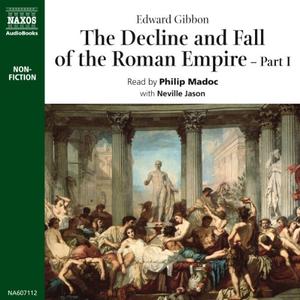
Free Download The Decline and Fall of the Roman Empire, Volume 1 - 6 by Edward Gibbon, Philip Madoc, Neville Jason
English | 2000 | ISBN: B0000546YV | Format: MP3 / Bitrate: 32 Kbps + PDF | 2.03 Gb
The Decline and Fall of the Roman Empire has always maintained its initial appeal to both the general public and scholars alike. Its sheer scale is daunting, encompassing over a millennium of history, covering not merely the Western Empire from the days of the early emperors to its extinction in AD 476, but also the Eastern Empire, which lasted for another thousand years until the Turks vanquished it in 1453. But Gibbon's style, part historical fact and part literature, is enticing, and the sheer honesty of the man, who endeavours to be scrupulously impartial in his presentation, endears him to the reader. In this recording, David Timson incorporates the most salient of Gibbon's footnotes.
In Volume I (chapters I-XV), Gibbon opens by setting the scene with the Empire as it stood in the time of Augustus (d. AD 14) before praising the time of the Antonines (AD 98-180). The death of Marcus Aurelius and the accession of Commodus and his successors ushers in turbulent and dangerous times which were only occasionally marked by a wise and temperate ruler. The volume ends in AD 324, with Constantine the Great becoming undisputed Roman emperor, uniting both the East and Western Empires.
In Volume II (Chapters XVI-XXVI), Gibbon continues his powerful history of the Empire, shining the spotlight on some of the best-known figures and their impact on the growing influence of Christianity, including Nero and, three centuries later, Constantine, whose establishment of Constantinople resulted in the division of the Empire into East and West. Gibbon also presents a sympathetic portrait of Julian, whose wisdom, courage and clarity bore the hallmarks of the great emperor that Rome needed.
In Volume III (chapters XXVII-XXXVI), Gibbon charts the fall of the Western Empire. Starting with the reign of Emperor Gratian (d. AD 383), his survey moves to political and religious issues in the East and West before covering the increasing military power of the Barbarians. Occasionally a great Roman general emerges to stem the tide, but internecine power struggles see the Western Empire weakened, until Gaul, Britain, Spain and other territories find themselves, as the 5th century advances, unable to rely on Rome for defence.
In Volume IV (Chapters XXXVII-XLVI), Gibbon explores the state of the Roman provinces after the dissolution of the Western Empire, and examines the reasons for its fall - not excluding its 'immoderate greatness'. He then moves to the Empire in the East and its rule under Justinian (527-565), whose formidable leadership saw the re-fortification of Constantinople and the frontiers of the Eastern Empire. However, dangerous times remain ahead as the Persians make attempts to siege Constantinople. Gibbon ends with the state of the Eastern Empire in the sixth century and its weaknesses after a long war.
In Volume V (Chapters XLVII-LVI), Gibbon further explores the influence of Christianity on the fall of the Roman Empire. He looks at the growth of the worship of Christian images and the resulting persecution by Leo III, emperor of the East. The conflict is intensified as a split develops between the Eastern and Western churches, a weakness that encourages attacks from Lombardy. Gibbon then moves to the foundation of the Moslem religion and the attempts of the Arabs to besiege Constantinople.
In Volume VI (Chapters LVII - LXXI), Gibbon ends his masterful history by charting the rise of the Turkish nation and the birth of the Ottoman Empire, which becomes an unstoppable force as it eventually captures the remains of the Eastern Empire. Weakened under the continuing schism of the Greek and Latin Christians, the strategically important site of Constantinople becomes an easy target for Sultan Mohammed II much to the consternation and apathy of the West.
